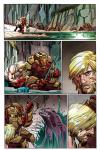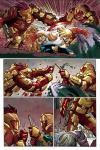|

By Jim Beard
Dimension Z—the name alone conjures up vivid images of alien vistas and challenges beyond human ken.
In CAPTAIN AMERICA #1, we discovered—alongside Cap—that bio-fanatic Arnim Zola’s otherworldly realm delivered on all those mental images and more. Dimension Z will stand as a true test of Steve Roger’s abilities to survive at all costs and win the day.
We got with CAPTAIN AMERICA writer Rick Remender for an exclusive tour of the Star Spangled Avengers’ home away from home for the near future; here he unveils its origins and his thoughts on what makes it tick.
Marvel.com: Rick, what’s your inspiration for the creation of Dimension Z? Where did the idea come from?
Rick Remender: The way the story was broken down, Dimension Z started off as a Hydra dimension. I thought it was interesting
if Hydra had a dimension. They were preparing their next attack, and this was where Hydra trained people. It was originally the cold open for the first issue, and then we spent a little more time with the Green Skull. That was literally like my first pass when I was taking the job and thinking things through. After some back-and-forth with [editor] Tom [Brevoort], we were talking about the sci-fi elements of it, and we decided that maybe the Green Skull stuff would be better pushed back, and to dust off a classic Cap villain.
At that point, I had already read the Jack Kirby’s [1970’s Captain America] stuff and I said “Well, let’s just make that dimension Zola’s dimension.” I had all these notes I had written for Zola for maybe the second or third arc, and it seemed obvious that the more I got into it, that was actually what I was fired up to tell. I took that cold open that was going to be Dimension H—take the H train to go hang out with Hydra—to the Zola of it all. You want a fish out of water situation. You want your character to be on the ropes. I think that it’s difficult because so many of the plans that I’ve got in place now for Dimension Z are such huge reveals. There’s about seven reveals throughout the first 10 issues that are giant, about the nature of Dimension Z, about what Dimension Z is.
On a macro level, it’s a place where Zola has absolute freedom to do his business. There is absolute freedom to experiment and to do whatever he wants and to then release his experiments into the wild of his own world. The more I delved into that, it became this sort of science fiction landscape. I didn’t have to follow the rules of “What would an alien civilization be like?” Yes, there are some indigenous people and some indigenous creatures in Dimension Z, but much of what’s there is the experiments of Arnim Zola, things he’s created and thrown into the wild to let evolve and run their course.
Marvel.com: Zola calls his lackeys “mutates,” so is there a sentient indigenous species in Dimension Z, and is that what the mutates spring from?
Rick Remender: Yeah, his mutate army is homegrown. There’s a couple of really fun, big reveals of what he’s been home-growing, but his basic army of mutates are just creatures that he’s created. Arnim Zola is the bio-fanatic. He is a guy who sees life as clay for him to mold and to create whatever he wants. He’s a complete sociopath. He has no empathy, he has no emotion. He has no cares for the feelings of others. He sees it all as a canvas for him to play with, to paint on and to create. He doesn’t see this as evil, and like artists, he’s constantly striving for perfection. The mutates to him are a perfect army: if you come for Arnim Zola, you have to fight through a huge army of the most evil, wicked, vicious beasts.
There’s not just the mutates that you see in CAPTAIN AMERICA #2. There are classic mutates that he’s created going back to the Kirby era, such as Doughboy, who we’ll be seeing more of, and some of these really crazy inventions, as well as new ones. The end of CAPTAIN AMERICA #4 is the big reveal of part of his master plan. I don’t want to reveal that, but I think it’s so much fun. In the situation he’s in, Zola’s not just creating mutates and other nefarious things. He’s got a plan here, and he’s got a motive that involves some human things, like family. He’s been working for a very long time on creating the perfect human being with his own genetic material. He, as a human, was sort of a weak and small man with a masculine father who berated him and was not proud of him, and it was that sort of dynamic. He’s now, with his own offspring, tried, via his mind and his scientific abilities to create the perfect scientific offspring, almost to spite his father who thought that his scientific leanings made him a goon. This is going way back to the 20’s, and we actually do flash back to a little bit of Zola’s origin as well, and get a look at him and what he was like.
The indigenous people that we meet in the second issue that play a role moving forward are the Phrox. This is a species that’s [native] to this world and this dimension, and what they’re up against is an ever-changing kaleidoscope around them of life and threats that Zola is introducing into their environment, so their lives suck now. Zola’s been there for some time doing this.
Marvel.com: So how long has Zola been in Dimension Z?
Rick Remender: The timeframe stuff, I’ve got a couple big reveals with so I want to dance around it a little bit. I will say that Zola does not age. Zola is a consciousness. He is a mind built within a bio-organic husk. In CAPTAIN AMERICA #1, you see that hulking classic Zola. He’s a badass. Zola is a force to be reckoned with in that body he’s got, but he doesn’t age. He is eternal now, and he’s been in Dimension Z for a long time. For a long, long time, obviously, because he’s built this city and you notice in the first issue the city’s covered in moss. That was something that was there for a reason. That mossy, overgrown “Zolandia” that he’s built in the middle of that canyon has been there for a long time, and he’s been experimenting for a long time. He’s been introducing his experiments into the wild for a long time.
This world isn’t just a canvas for him to play on; it’s a canvas for me to play on. Every time you’re in Dimension Z in the wastelands, every time I cut back to Cap and Ian and what they’re up against, it’s something that I can do almost anything with because Zola could have created anything I can think of. That to me is sort of the fun of doing something that is pulp science fiction where that’s enough explanation. Why is there a giant ant with a soft, fleshy human face? Zola made it.
Marvel.com: What was Dimension Z like before Zola arrived? Did it resemble Earth at all?
Rick Remender: In my head, Dimension Z was just an alien world where the Phrox, the indigenous people—you usually come across that peace-loving “Hey man, there’s like a tribe of aliens, and they’re just like super peace-loving hippies.” They weren’t really like that. They were a warring species, and they were unfamiliar with concepts such as democracy. The world itself doesn’t follow any of the rules that we’re used to. We’re used to a very organized, ordered sort of universe where the sun rises every day and sets every day in the same basic place, gravity works basically the same, time is mostly the same. I know that the further away you get from Earth, the difference of gravity changes, the flow of time, but these are all things that are generally the same.
In Dimension Z that’s not the case. The two suns that cook during the day rise from different horizons every day, so it’s impossible to ever use them for bearings. The constellations are always changing because the orbit the planet is in is wacky. All of the physics that Steve would use to understand and survive on Earth are thrown off in Dimension Z. It’s almost a wonderland in that there’s nothing familiar. You can’t count on anything. It goes from being summer to winter in a day, and when it goes to winter it becomes extremely difficult to survive. It’s not just winter, it’s an extreme winter.
Marvel.com: So it’d be very disorienting for humans—like Cap—if we were there.
Rick Remender: Yeah, and the snow is a different compound; it’s gaseous. The long and the short of it is that I wanted it to feel completely alien and I wanted Cap to be disoriented. When he gets lost in the middle of Dimension Z with his young ward Ian that he has to care for, there’s no way to know how to get back to Zola’s city to find that tunnel to get back home. Any of the things you would use to understand, like, “The sun does rise here, so I know we’re traveling in the same direction,” that’s all off. There are other kinds of seasons. There’s gas storms, there’s oceans of gaseous fire, and then all the creatures that live there. It’s a world of insanity and danger. I wanted that. He needs to feel disoriented. Not just off balance, but almost in a situation of complete hopelessness. Beyond the science fiction aspect, I wanted it to be like “Castaway” meets “The Road,” tonally.
Marvel.com: Would you say that Steve Rogers has a greater capacity than most of us to roll with a new situation? He was once a young man who was suddenly in the European Theater and the Pacific Theater in World War II, and then he was a man who jumped in time, too…
Rick Remender: That was a big part of what I wanted to do with Dimension Z, to double down on the “man out of time” aspect of his character. Without giving away what’s going to happen by the end of the story, that gets played up in a pretty big way. There are big changes. I wanted to take the status quo of Captain America and shatter it with a ball peen hammer so that it was unrecognizable, and to no longer keep having to build his character traits and what he’s dealing with off of World War II and being a man out of time who was frozen and awoke in what I guess in Marvel time would be a decade ago. That stuff has been explored, and it’s been done by a lot of guys who are pretty damn amazing. It’s all established.
What my series is going to do is set him up with a whole new chapter of his life equally as disorienting and equally as big a shift, so that when everything is said and done with Dimension Z, it’s a very different character dealing with a whole new supporting cast, dealing with a lot of new things and dealing with the repercussions of what he had to do in order to deal with the Zola threat and Dimension Z in general.
Come back later this week to learn more about Dimension Z and CAPTAIN AMERICA from Rick Remender!
|









